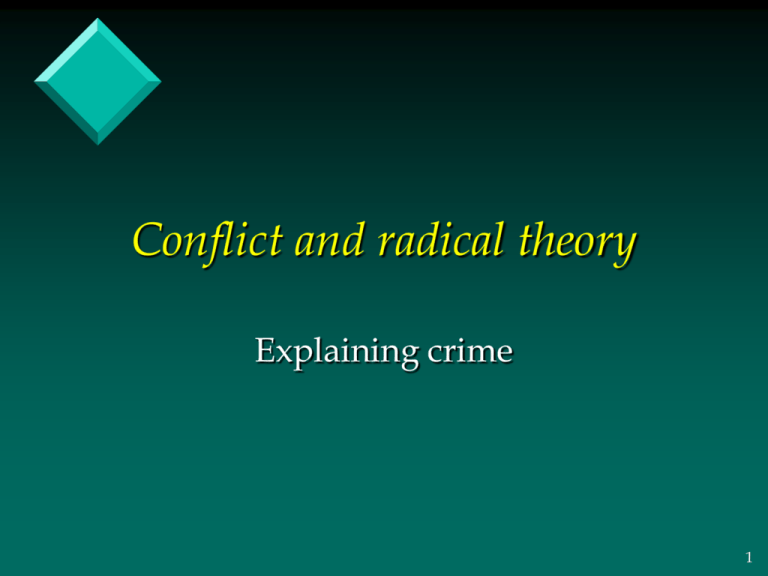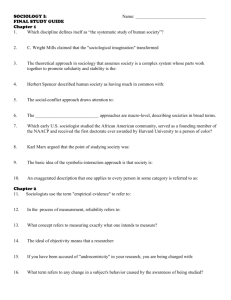Conflict and radical theory
advertisement

Conflict and radical theory Explaining crime 1 Culture deviance theory People in poverty cope by creating an independent subculture with its own set of rules and values Middle class: hard work, delayed gratification, formal education, caution Lower class (Miller) argued that there are different rules on the street 2 Miller (cont) Those who follow the street rules of lower class life find themselves in conflict with the dominant middle class culture Focal concerns in street culture (not a rebellion--evolved to deal with conditions in slums) Miller identified six such concerns 3 Focal concerns 1. Trouble: involvement in fighting, drinking, etc. 2. Toughness: strength, fighting ability, athletic skill 3. Smartness: being street-wise, able to outcon others 4. Excitement--search for fun to enliven a drab life--gambling, fighting, drinking 4 Focal concerns 5. Fate: what happens is fate, luck 6. Autonomy: personal freedom, resistance against controlled environments, such as schools, CJS, etc. These concerns put people at odds with those of the larger culture, and make them more likely to get into trouble 5 Conflict theory Crime is a function of conflict The more conflict in a society, the more crime Societies with little conflict, little crime Sellin and culture conflict theory Primary culture conflict: two cultures come into conflict. Less dominant culture will have the higher crime rate 6 Culture conflict Examples can be seen worldwide Secondary culture conflict: a subculture within a society is at odds with the dominant culture According to conflict theorists, conflict might be over money and other material goods, power, or how a particular issue is decided 7 Conflict (cont) Societies may have a variety of groups, all competing for different goals and prizes These groups are dynamic, and change Sometimes groups might come together over a particular issue Even a powerless group might obtain power by banding together 8 Conflict (cont) Generally, there are likely to be some groups that consistently have more power than others They determine the laws, and carry them out; different groups may be treated differently 9 Radical and Marxian theory Marx Dialectic: thesis, antithesis, synthesis Change due to conflict of competing economic systems History is a succession of economic arrangements, as the weak struggle against exploitation by the powerful Succession of ever-improving systems 10 Marx (continued) Progress is attained by the rise and fall of economic systems Major epochs in history: 1. ancient slave 2. feudalism 3. capitalism 4. socialism 5. communism 11 Marx (cont) All economic orders have been characterized by the class struggle Class is the great divider The ruling class owns everything and forces workers into exploitation Capitalism overthrew feudalism, provided goods to more people, and instituted constitutional government 12 Marx (cont) However, the workers are still exploited, paid a fraction of their worth 19th century working conditions, child labor Marx believed that the workers would rise up, take over the means of production. Capitalism will be replaced by socialism, and then by communism 13 Marx (cont) When the means of production are no longer owned by individuals, the class struggle will cease. The state will wither away. “From each according to his ability, to each according to his need.” Marx thought that crime was a function of the economic system--capitalism 14 Marx continued Modern capitalist societies involved a perpetual class struggle Ruling class determines what is a crime, based on their own self-interests, and create the CJS to support it. They create social conditions which create criminals out of the working class 15 Marx (cont) When people are freed from the class struggle, people will become cooperative, and the result will be a crime-free society People are inherently good, there will be little or no crime in a communist society 16 Modern radical theorists (Quinney) Marx’s predictions did not all turn out as expected Revolutions occurred in feudalistic societies such as Russia and China, rather than Germany and Great Britain. The revolutions did not take place in western Europe or the U.S. Radical theorists attempted to explain 17 Radical American society is based on an advanced capitalist economy Very large middle class involved in service occupation a shrinking manufacturing and agricultural base a small group of private owners 18 Radical These changes, particularly the increasing size of the middle class, helped to prevent revolution The state is still organized to serve the interests of the ruling class, and the CJS represents ruling class interests in preserving domestic order 19 Radical (cont) Advanced capitalism requires that the lower classes remain oppressed by whatever means necessary, especially through the coercion and violence of the legal system Capitalism will collapse--the workers are still oppressed. Furthermore, the middle class becomes more sophisticated 20 Radical (continued) Only when capitalism is replaced by socialism, will there be a solution to the crime problem Criminologists are merely servants to capitalism, reinforce its values Criminologists should develop a political movement to promote revolution 21 Radical--comments Methodological rigor is lacking. It is the case, however, that they have pointed out that a very small number of people are disproportionately wealthy Socialistic countries have crime problems “Nature of man” issue 22 Economy and crime Economics: study of production, distribution, exchange and consumption of goods Occupies a major portion of human activities Economy and crime 23 Economy: Methodological Problems Two types of studies Cross-sectional--different economies, same time Longitudinal--one economy over time Problems 1. Data are not always accurate (UCR, economic indices--unemployment) 24 Methological (cont) 2. Correlational studies: economy might alter crime rate, but also vice versa, or the economy and crime may be affected by other factors. Cannot do an experiment 3. Time lag--how long does it take an economic event to affect crime? 4. Poverty is subjective 25 Hypotheses about economy 1. Declining economy (poverty, need) hypothesis: as the economy gets worse, the crime rate will increase Lack of legimate job opportunities drives people to crime (strain) Capitalism encourages greed, and the CJS criminalizes the greed of the poor (Marxist/radical) 26 Hypotheses (cont) 2. As the economy gets better, the crime rate will increase When people are more affluent, there is more worth stealing, more temptations (i.e., auto theft) With affluence, there are more criminal opportunities (drugs, gambling, etc.) 27 Hypotheses (cont) 3. Relative deprivation: Perceived economic inequality affects crime rate. People perceive inequality, feel unfairly treated, resentment and frustration, aggression and crime (envy hypothesis) Outgrowth of reference group (or social comparison) theory. Satisfaction depends on who one compares onself with--effects of television 28 Hypotheses (cont) 4. Common cause hypothesis: Unemployment and crime are caused by common factors Impulsivity, low verbal intelligence, sensation-seeking, dropping out (dropouts two times as likely to be unemployed) 29 Hypotheses (cont) 5. Crime may cause unemployment: if crime pays, people may become unemployed 6. No relationship 30 Research on need hypothesis TARP project: provided money to parolees no effect on recidivism of young males Less recidivism among older males and those with families Manpower project: added training. Again, effective with older males, and with females 31 Income inequality GINI Index Measure of Income disparity Ranges from 0 to 1 0 would indicate that everyone had the same amount Lower coefficient indicates a higher level of economic equality 32 GINI Denmark: 24.7, Japan 24.9 Russia 31, Canada 33, UK and Italy 36 U.S. ranks 92nd out of 124 nations, with 46.6, more income inequality All of the nations higher than this are 3rd world countries 33 Income inequality Highest are Sierra Leone, Botswana, Lesotho (around 63), Namibia the highest with 70.7 GINI index highly correlated with homicide rates—higher GINI index, higher homicide rates 34








